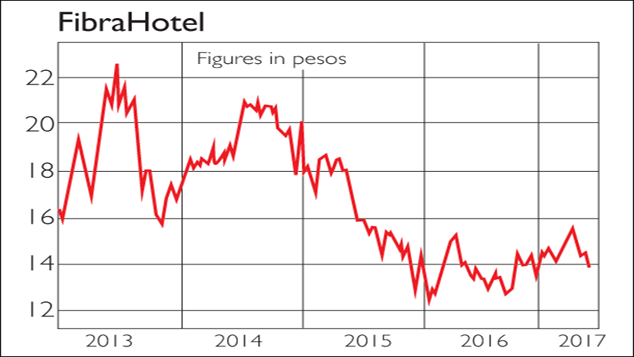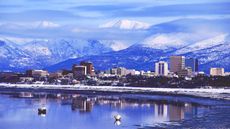Investors should follow the tourists into Latin America
Latin America is putting its violent past behind it, and is poised to ride the wave of a global tourism boom. Invest now to reap the rewards, says James McKeigue.

Latin America is putting its violent past behind it, and is poised to ride the wave of a global tourism boom. Invest now to reap the rewards, says James McKeigue.
I'll never forget my first visit to Colombia in 2007. First, I survived a robbery attempt as I crossed the border from Ecuador. Then later that day, a police station blew up in front of me. It was quite an experience for a freelance journalist looking for stories. But in hindsight, it was also a last hurrah for the old Latin America.
Today, Colombia's murder rate has fallen sharply, as it inches towards a peace deal with the guerrillas who have battled the government since the 1960s. Peru, meanwhile, defeated its terrorists in the 1990s, and Nicaragua has healed the wounds of its civil war to become the safest country in Central America.
Subscribe to MoneyWeek
Subscribe to MoneyWeek today and get your first six magazine issues absolutely FREE

Sign up to Money Morning
Don't miss the latest investment and personal finances news, market analysis, plus money-saving tips with our free twice-daily newsletter
Don't miss the latest investment and personal finances news, market analysis, plus money-saving tips with our free twice-daily newsletter
The decline of violence is, of course, to be welcomed for many reasons. But one should be of particular interest to investors: the potential that peace and a greater sense of economic stability creates for a tourism boom. It might take some time for Latin America's international image to improve the popularity of films and TV shows that portray it as a land of cruel dictators battling violent rebels and ruthless drug barons certainly doesn't help but as the generally peaceful reality becomes clear, it will attract growing numbers of international visitors.
That's worth watching, because tourism is big business in fact, according to the UN's World Tourism Organisation (UNWTO), it is the third-largest export industry in the world, with around $4bn spent on tourism each day. In 1950, across the entire globe, 25 million international journeys were taken.
Last year, there were 1.2 billion, and by 2030 that number is expected to rise to 1.8 billion, reckons the UNWTO. This growth has proved remarkably resilient over the years, continuing throughout regional crises, global economic downturns, disease scares and armed conflicts. It is also a global phenomenon UNWTO expects all areas of the world to see growing numbers of visitors between now and 2030.
Clearly, booming tourist numbers are great news for the global aviation industry. However, some areas will do better than others, and the biggest trend is set to be the growing importance of emerging markets to the global tourism business. For now, the world's rich countries still dominate the rankings, receiving 55% of all international visitors.
Yet between now and 2030 the number of arrivals to emerging destinations is expected to grow at 4.4% a year, twice the rate of arrivals to advanced economies (2.2%). The good news for investors is that Latin America looks particularly well placed to benefit from this global boom and with the region emerging from recession, now could be the ideal time to invest.
Why Latin America?
At the start of this decade the long commodity boom went into reverse. First the price of metals and minerals collapsed, then the slowdown moved onto oil, and eventually even reached agricultural products. This slump hit Latin America very hard. Copper, iron ore, gold, silver, soybeans and oil are all major Latin American exports, and the falling price of these commodities undermined growth across the region. Worst hit were the commodity-dependent Andean countries of Chile, Colombia, Peru, Ecuador and Venezuela.
However, with the exception of the latter two (which don't have free-floating currencies), the slide in commodity prices came with a strong silver lining massive currency depreciation. The Chilean peso, the Colombian peso and the new Peruvian sol very quickly lost around a third of their value against the US dollar.
That helped to make these countries' non-commodity-related industries a lot more competitive. Of those, tourism was the first to benefit. Unlike manufacturers, who have to be convinced that currency depreciation is permanent before they are willing to invest in expanding production in order to capitalise on overseas demand for their goods, tourist businesses are ready to reap the gains as soon as international visitors realise that their country has suddenly become a lot cheaper and come flocking in.
In 2015, the last year for which the UNWTO has full figures, the numbers of international visitors to Chile grew by 22%, to Colombia by 16%, to Peru by 7% and to Uruguay by 3%. Early signs suggest that this double-digit growth continued in Chile and Peru last year, bringing the number of tourists visiting these countries to record highs.
Of course, Latin America's powerful northern neighbour is an important factor in this growth America is the second-biggest spender on tourist services in the world, and Latin America is a reasonably convenient destination for the more adventurous American tourist. So strong employment growth and the apparently sound economic backdrop in the US are good news for Latin American tourism. Depreciation is also a plus for international investors (like us) who are looking to invest in the region, as it means we can invest more cheaply than before and hopefully benefit from future currency appreciation too.
The fall in the value of local currencies, meanwhile, has also convinced more Latin American citizens to take holidays in their own country or within the region, rather than travel abroad and spend in dauntingly expensive dollars and euros.
Yet even in the absence of currency depreciation, this is a vital source of ongoing growth in the industry according to the UNWTO, around 80% of international journeys start and end within the same region. Indeed, this is one of the main reasons that the tourist industry in emerging markets is growing more quickly than in mature ones. As economies expand, so do the number of individuals with both the wherewithal and the desire to explore their neighbouring countries.
Interregional visitor numbers in Latin America are only likely to grow even more strongly in the coming years. The region has just endured two consecutive years of recession, but is set to return to growth this year. This was largely down to Brazil's economic woes most of the area has in fact been growing steadily for the past few years. And now that the Brazilian behemoth which accounts for almost half of Latin America's GDP is emerging from its worst recession on record, the region's tourist industry should be a big beneficiary.
Greater safety, better facilities
Clearly, some Latin American countries still have a serious crime problem Venezuela, El Salvador, Guatemala and Honduras are the most egregious examples. But, with the exception of Venezuela, where the government is losing control of crime in the same way that it has lost control of everything else, this violence isn't necessarily a barrier to tourism. El Salvador, Guatemala and Honduras do have security problems. But the first two in particular are far safer than they were during the 1980s when they were torn apart by civil war.
Moreover, from a hard-headed investment perspective, the violence in these countries tends to be restricted to poor people living in the sprawling urban ghettos. This is a tragedy and a problem for those societies, but this sort of crime has no impact on tourists visiting the main attractions, which tend to be very safe. This is already being reflected in Central America's improving tourist numbers. International arrivals rose by 7% in 2015 to exceed ten million for the first time. Panama led this growth with a 21% increase in arrivals. Belize welcomed 6% more arrivals, Costa Rica and Honduras 5%, El Salvador and Nicaragua 4%, and Guatemala 1%.
Another long-term factor in Latin America's favour is the region's improving transport links. Poor infrastructure has long been one of the major hurdles to improving economic productivity in the region. But thanks to the decade-long commodity boom from 2003, which poured money into most Latin American countries' economies, recent years have seen huge investments in road transport. Tens of billions of dollars have been spent on roads, tunnels and bridges that have improved overland travel within and between Latin American countries. The transformation in Ecuador, Colombia, Peru, Nicaragua and Panama has been particularly impressive.
The benefits of the improvements are twofold: on one hand it makes it easier for regional travellers to visit neighbouring countries, while on the other, it makes Latin America more attractive to those coming from further afield, as they can visit more tourist hotspots during their stay. The Ecuadorian road network has improved to the point where it is now possible for a tourist travelling by car to breakfast in the Amazon jungle, have lunch in the Andean highlands, and then enjoy the sunset on the Pacific Coast with their dinner.
High-flying Latin American airlines
The other big change has been in the airline business, where new competitors have sprung up to challenge Latin America's lumbering aviation oligopoly. The old system of protected, inefficient national airlines has been swept aside by a wave of liberalisation. Panama's Copa, Colombia's Avianca, Brazil's Gol, Mexico's Aeromexico and Chile's Latam are now globally competitive airlines that offer Latin American customers the level of prices and flight frequencies that we've long taken for granted in the UK. Indeed, Latam, formed by a merger between Chilean and Brazilian rivals, is now Latin America's largest airline.
Budget airlines are being launched too. Until recently just Mexico, Colombia and Brazil benefited from low-cost carriers, but now they are spreading out across the region. The International Air Transport Association (IATA) reckons that airline passenger numbers in Latin America are growing at a rate of 4.8% a year, making it one of the world's fastest-growing air-traffic regions. Aircraft-maker Boeing is even more optimistic about the future, pencilling in 5.8% growth per year for the next few decades.
Investors should always regard long-term statistics with a healthy dose of scepticism but investment is already being made in new airports to cope with the extra traffic. Mexico, Brazil, Ecuador, Costa Rica and Colombia are just some of the Latin American countries currently working on major new airports. Not bad when you consider the decades that we've wasted talking about fixing London's airport capacity problem.
The three stocks to buy now
Mexican airport operator Grupo Aeroportuario del Centro Norte (Nasdaq: OMAB) manages 13 airports across nine states in northern and central Mexico, serving Monterrey, the industrial heartland, and tourist destinations such as Acapulco, which means it benefits from leisure and business travel. It also makes money leasing out airport concessions and managing hotels and parking facilities.
The share price tanked when Donald Trump became US president due to fears that anti-Mexico policies would lead to less travel between the two countries. As investors have decided Trump's bark is worse than his bite, the share price has rallied somewhat. On a forecast price/earnings (p/e) ratio of 19.5, it's not cheap (although it yields 4%). But long term it should benefit from Latin America's fast-growing number of international visitors.
Panama's Copa Holdings (NYSE: CPA), owner of Copa Airlines, uses its strategic location in the business hub of the Americas to operate flights to 70 destinations in Latin America and the Caribbean. It has a more extensive network of intra-Latin American flights than any other airline, and late last year it also launched a Colombia-based, low-cost carrier, Wingo, which means it should benefit from growing interregional tourism.
Copa's first-quarter results showed a healthy 9.9% increase in traffic and a 6% rise in revenue per available seat mile, driven mainly by growing sales in Colombia, Brazil and Argentina. Copa has a good record of controlling costs, yet is cheaper than many of its Latin American rivals on a forward p/e ratio of under 13.5 about half that of Chile's Latam. It also has a 1.8% dividend yield, more than most peers.
Concentradora Fibra Hotelera Mexicana (Mexico: FIHO12), or simply FibraHotel, is a real-estate investment trust (Reit) that owns the largest hotel portfolio in Mexico. It has 75 hotels up and running, with ten more due to be added this year. FibraHotel doesn't operate the hotels: instead, it owns and develops the land and buildings, which it leases to select hotel brands. It is mainly focused on business hotels and partners with mid-market brands such as Marriott and Sheraton.

As the Latin American travel boom increases demand for hotels, Fibra will continue to generate healthy revenues to redistribute to its investors. Meanwhile, its aggressive real-estate acquisition and development will boost the value of its holdings.
The US$370m market-cap Reit has grown incredibly quickly over the last few years (it floated in late 2012 with just 34 hotels). As it consolidates and more of its hotels become operational its medium-term target is 100 it will be able to distribute more cash to holders. At the moment, its payout amounts to a dividend yield of around 8%, and that is expected to continue growing. The firm trades on a forecast price to funds from operations (P/FFO) of 9.5, compared with around 11 for its nearest peer, Fibra Inn.
James graduated from Keele University with a BA (Hons) in English literature and history, and has a NCTJ certificate in journalism.
After working as a freelance journalist in various Latin American countries, and a spell at ITV, James wrote for Television Business International and covered the European equity markets for the Forbes.com London bureau.
James has travelled extensively in emerging markets, reporting for international energy magazines such as Oil and Gas Investor, and institutional publications such as the Commonwealth Business Environment Report.
He is currently the managing editor of LatAm INVESTOR, the UK's only Latin American finance magazine.
-
 British Airways revamps Avios scheme bringing down flight prices to £1
British Airways revamps Avios scheme bringing down flight prices to £1With the new Avios part-payments scheme you can now bag a British Airways flight for as little as £1
By Oojal Dhanjal Published
-
 RBS to close a fifth of branches
RBS to close a fifth of branchesRoyal Bank of Scotland plans to shut 18 branches across Scotland, resulting in the loss of 105 jobs. We have the full list of closures.
By Ruth Emery Published
-
 Governments will sink in a world drowning in debt
Governments will sink in a world drowning in debtCover Story Rising interest rates and soaring inflation will leave many governments with unsustainable debts. Get set for a wave of sovereign defaults, says Jonathan Compton.
By Jonathan Compton Published
-
 Why Australia’s luck is set to run out
Why Australia’s luck is set to run outCover Story A low-quality election campaign in Australia has produced a government with no clear strategy. That’s bad news in an increasingly difficult geopolitical environment, says Philip Pilkington
By Philip Pilkington Published
-
 Why new technology is the future of the construction industry
Why new technology is the future of the construction industryCover Story The construction industry faces many challenges. New technologies from augmented reality and digitisation to exoskeletons and robotics can help solve them. Matthew Partridge reports.
By Dr Matthew Partridge Published
-
 UBI which was once unthinkable is being rolled out around the world. What's going on?
UBI which was once unthinkable is being rolled out around the world. What's going on?Cover Story Universal basic income, the idea that everyone should be paid a liveable income by the state, no strings attached, was once for the birds. Now it seems it’s on the brink of being rolled out, says Stuart Watkins.
By Stuart Watkins Published
-
 Inflation is here to stay: it’s time to protect your portfolio
Inflation is here to stay: it’s time to protect your portfolioCover Story Unlike in 2008, widespread money printing and government spending are pushing up prices. Central banks can’t raise interest rates because the world can’t afford it, says John Stepek. Here’s what happens next
By John Stepek Published
-
 Will Biden’s stimulus package fuel global inflation – and how can you protect your wealth?
Will Biden’s stimulus package fuel global inflation – and how can you protect your wealth?Cover Story Joe Biden’s latest stimulus package threatens to fuel inflation around the globe. What should investors do?
By John Stepek Published
-
 What the race for the White House means for your money
What the race for the White House means for your moneyCover Story American voters are about to decide whether Donald Trump or Joe Biden will take the oath of office on 20 January. Matthew Partridge explains how various election scenarios could affect your portfolio.
By Dr Matthew Partridge Published
-
 What’s worse: monopoly power or government intervention?
What’s worse: monopoly power or government intervention?Cover Story Politicians of all stripes increasingly agree with Karl Marx on one point – that monopolies are an inevitable consequence of free-market capitalism, and must be broken up. Are they right? Stuart Watkins isn’t so sure.
By Stuart Watkins Published